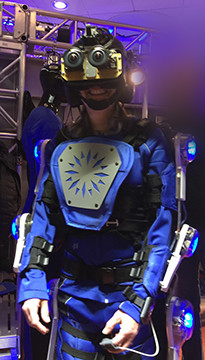
I had a chance the other day to see what it feels like to be 85 years old.
I’d read about the Genworth R70i Aging Experience and when I discovered the exhibit was making a brief appearance near me at the Liberty Science Center in New Jersey, I headed over with my 9-year old assistant to see what it was all about.

The Aging Experience involves a high-tech suit designed to help younger people gain insight into the physical effects associated with aging. When I told residents I was going to age myself via the suit, reactions ranged from an incredulous, “Why in the world would you want to do that?!” to “Great! We can compare notes,” to, “Can they make a suit to make you feel twenty-five?”
My assistant and I arrived 15 minutes before the 11 a.m. demonstration so that I’d be dressed and ready. The Applied Minds staff, who partnered with Genworth on this project, took us into the back of a tech-filled room where they Velcroed various parts of the suit onto me, adding an extra 40 pounds strategically placed to mimic age-related weight gain.
This resulted in the constant thought throughout the half-hour presentation that it would be really nice to sit down.
The helmet included goggles and headphones, so that they could give me various disorders including glaucoma, macular degeneration, cataracts, age-related hearing loss, tinnitus and aphasia. I was finally able to see what one of my patients referred to when she said, “I have macular,” as if she was intimate enough with the condition to be on a first name basis.
After undergoing vision and hearing loss, I was faced with rheumatoid arthritis and hip problems that made walking on the treadmill a chore. Even without the additional physical challenges, trudging on the virtual beach was so difficult that I estimated a two-minute hike would be enough before it lost its pleasure – and I love walking on the beach.
The audience was able to observe my heart rate and perceptions on the screens behind me and then to try on goggles and headsets and experience the ailments themselves.
There were unexpected side benefits to my demonstration too. My young helper pledged to always wear good sunglasses to shield her eyes and to keep the volume on her headset low to protect her ears, just as the staff recommended. Then she came home and advised her father to do the same.
Bringing the experience to staff
The aging suit would help enhance empathy for elders at a large long-term care conference, but I see the most benefit in offering the opportunity to direct care workers who interact with residents daily. They’re the ones who need to know what it means to have “macular” and not be able to see the salt packets because they blend into the placemats on the food trays. (And the person ordering white placemats should be encouraged to choose a contrasting color.)
If the Genworth R70i tours your area, perhaps a group excursion could be arranged. But if not, there are other ways to help staff walk a mile in the moccasins of their residents. Considering adding some of these suggestions to your staff training:
• Give aides a ride in the patient care lift so they can see what it feels like to swing from bed to chair and back. I guarantee there will be fewer casual conversations between staff members during the transfer and more reassuring explanations to new residents about each step of the procedure.
• Ask your rehab staff to add weights to trainees to simulate age-related weight gain and have them try to walk around the room — or even just stand for a while.
• Use headsets to mimic hearing loss and ask attendees to follow verbal instructions.
• Use goggles to mimic visual impairment and have trainees look for items among several on a tray table.
• Offer wheelchair rides. (Hint: It feels a lot faster being pushed than it does when you’re pushing.)
• Have the residents explain what it’s like to have various illnesses and what the staff can do to help them manage.
Unless we’ve been residents ourselves, it’s difficult for us to know exactly what they are experiencing in our facilities. Opportunities like this can bring us closer to their daily realities and help us train staff, modify approaches and improve customer service.
It could mean the difference between being an OK caregiver and an outstanding one.
Eleanor Feldman Barbera, Ph.D., author of The Savvy Resident’s Guide, is a 2014 Award of Excellence winner in the Blog Content category of the APEX Awards for Publication Excellence program. She also is the Gold Medalist in the Blog-How To/Tips/Service category of the 2014 American Society of Business Publication Editors Midwest Regional competition. A speaker and consultant with nearly 20 years of experience as a psychologist in long-term care, she maintains her own award-winning website at MyBetterNursingHome.com.





